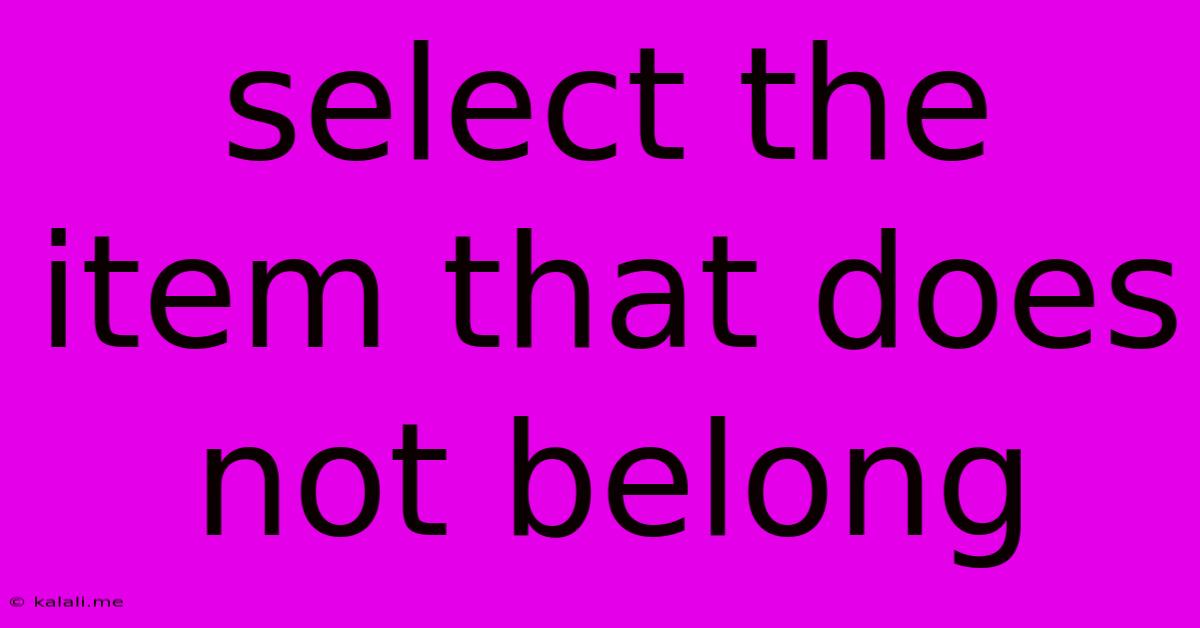Select The Item That Does Not Belong
Kalali
Jun 12, 2025 · 2 min read

Table of Contents
Select the Item That Doesn't Belong: Mastering a Classic Test Question Type
The "select the item that doesn't belong" question type is a staple in various assessments, from standardized tests to classroom quizzes. This seemingly simple question format actually tests a wide range of cognitive skills, including critical thinking, pattern recognition, and deductive reasoning. This article will delve into strategies to master this question type, exploring different approaches and offering practical examples. Understanding the underlying principles will boost your performance significantly, whether you're preparing for an exam or simply sharpening your analytical skills.
Understanding the Core Concept
At its heart, this question type challenges you to identify the outlier – the element that doesn't share a key characteristic with the others in the set. This "key characteristic" can be anything from a shared property or function to a relationship or pattern. The difficulty lies in identifying this underlying connection and subsequently, the item that deviates from it.
Effective Strategies for Success
1. Identify Commonalities: The first step is always to look for similarities between the items. List the shared traits; these could be physical attributes, functional roles, categories, or even abstract concepts. For example:
- Example Set: Apple, Banana, Carrot, Orange
- Commonality: Fruits
This immediately points to the outlier: Carrot.
2. Consider Different Perspectives: Don't limit your analysis to the most obvious connections. Consider various perspectives and potential relationships. The commonality might not be immediately apparent.
- Example Set: Square, Circle, Triangle, Rectangle
- Commonality (Obvious): Geometric shapes
- Commonality (Subtle): All except the circle have straight sides.
3. Eliminate Options Systematically: Once you've identified potential commonalities, systematically eliminate options based on whether they fit the established pattern. This helps refine your focus and increase your chances of selecting the correct answer.
4. Look for Exceptions: Sometimes, the "doesn't belong" item is not just different but actively defies a rule or pattern established by the rest.
- Example Set: 1, 3, 5, 7, 9, 12
- Commonality: Odd numbers
- Outlier: 12 (an even number)
5. Practice Regularly: Like any skill, mastering this question type requires practice. Work through numerous examples, focusing on diverse themes and levels of difficulty. Regular practice will build your pattern recognition abilities and improve your speed and accuracy.
Beyond Simple Comparisons
While many questions involve straightforward comparisons, some questions introduce higher-level thinking. These might include:
- Analogies: The outlier might not share a direct characteristic but rather a relational one.
- Abstract Concepts: Questions could involve abstract ideas, requiring a deeper understanding of underlying principles.
- Complex Relationships: Multiple relationships might exist, with the outlier violating more than one.
By mastering the strategies discussed above and engaging in regular practice, you can significantly improve your ability to successfully answer "select the item that doesn't belong" questions. The key is to be methodical, look beyond the surface, and consider different perspectives to unravel the hidden connections and pinpoint the outlier. Remember, practice makes perfect!
Latest Posts
Latest Posts
-
Truth Table For 3 Input And Gate
Jun 13, 2025
-
The Study Of Universe Is Called
Jun 13, 2025
-
Fluid Part Of Blood After Removal Of Corpuscles Is
Jun 13, 2025
-
What Is The Molecular Mass Of Calcium Nitrate
Jun 13, 2025
-
What Do Dna Proteins And Fats Have In Common
Jun 13, 2025
Related Post
Thank you for visiting our website which covers about Select The Item That Does Not Belong . We hope the information provided has been useful to you. Feel free to contact us if you have any questions or need further assistance. See you next time and don't miss to bookmark.